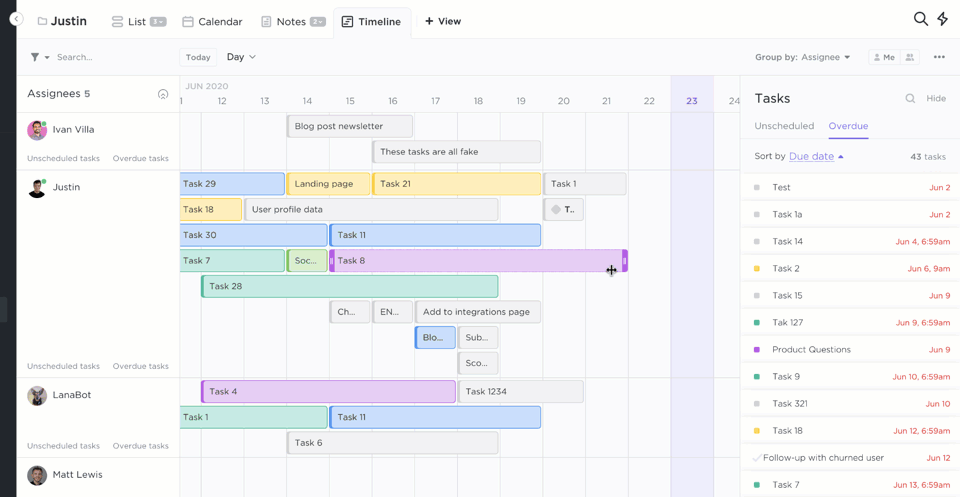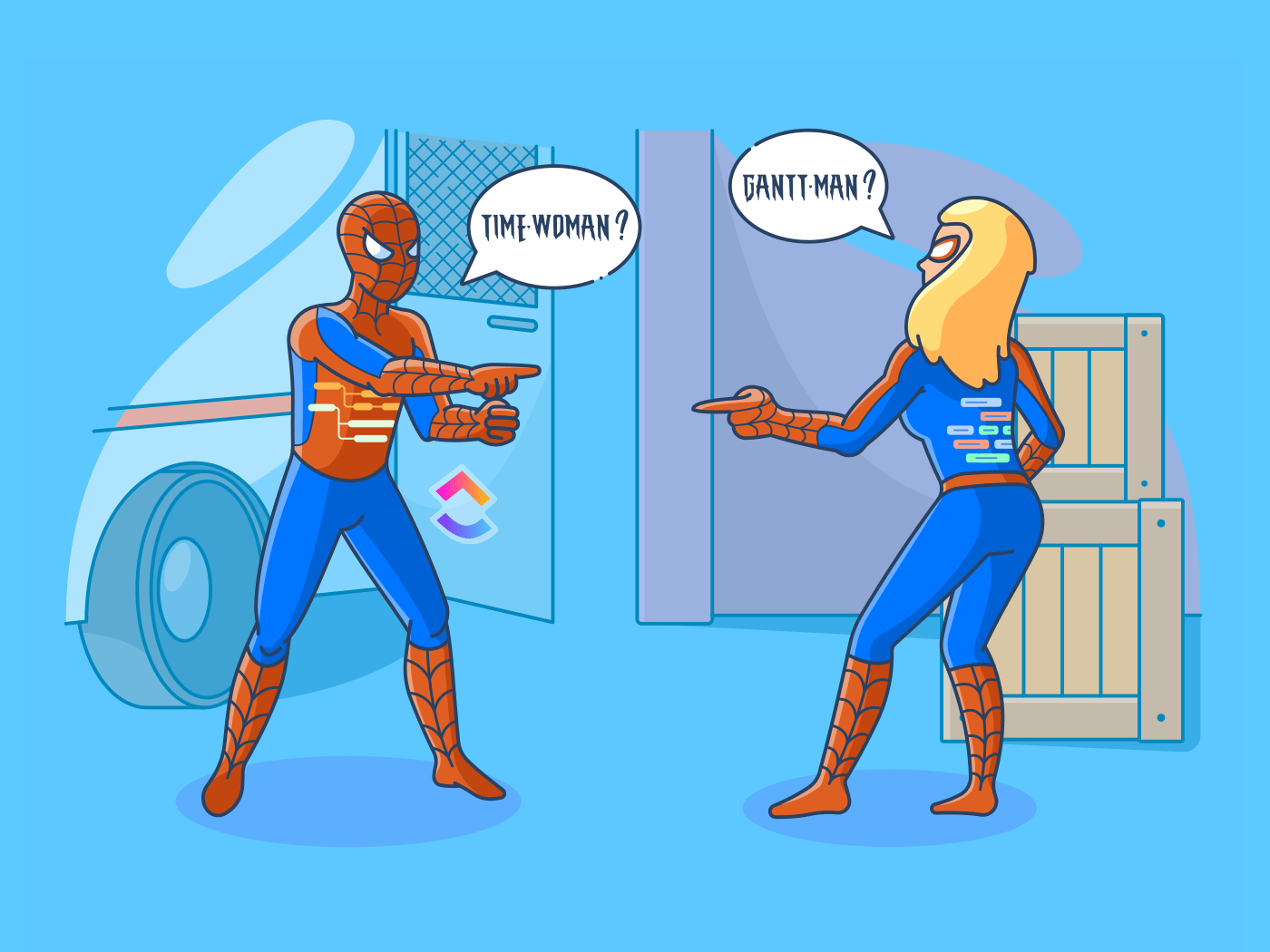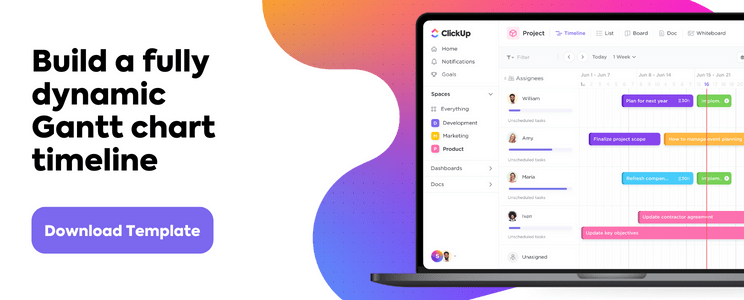_هل تريد معرفة الفروق بين مخطط جانت والمخطط الزمني؟
إذا كنت مدير مشروع، فمن المحتمل أن تكون على دراية بكلتا هاتين الأداتين.
ففي النهاية، كلاهما مخطط جانت والجدول الزمني لمساعدتك في الحصول على نظرة عامة مفصلة عن المشروع.
ومع ذلك، نظرًا لأنهما متشابهان إلى حد ما، يتم الخلط بينهما.
مثلما يخلط الناس بين السلاحف والسلاحف. إحداهما تعيش على اليابسة والأخرى تحب الماء. لكننا لسنا هنا للحديث عن الزواحف..
إذن، ما الفرق بالضبط بين مخطط جانت والجدول الزمني؟
يتمثل الفرق الرئيسي بين المخطط الزمني ومخطط جانت في أن المخطط الزمني يحتوي على أحداث مرئية على خط واحد بينما مخطط جانت عبارة عن مخطط ثنائي الأبعاد لتسلسل المهام وتبعياتها.
تعطي الجداول الزمنية أصحاب المصلحة نظرة عامة عالية المستوى لبداية المشروع ونهايته ومراحله الهامة.
تسمح مخططات جانت لمديري المشاريع بالتحكم في تقدم المشروع و تفويض المسؤولية للمهام الفردية.
في مقالة المقارنة بين مخطط جانت والجدول الزمني هذه، سنغطي ما هو مخطط جانت والجدول الزمني ولماذا تحتاج إليهما. سنشرح أيضًا بمزيد من التفصيل كيف يختلفان عن بعضهما البعض وكيف يختلفان أيضًا عن تقويم المشروع.
وأخيراً، سنوضح لك كيف برنامج إدارة المشاريع تحسين عمليات إدارة المشاريع في شركتك.
ما هو مخطط جانت البياني؟
مخطط جانت هو تمثيل بياني لتقدم مشروعك بمرور الوقت.
لا تكشف مخططات جانت عن التقدم المحرز في مشروعك فحسب، بل إنها تعطي أيضًا نظرة عامة واضحة عن:
- الجدول الزمني للمشروع بأكمله
- تقديرات الوقت
- أعضاء فريق المشروع المعينين
- أولويات المهام
- تبعية المهام
كما أنها تشبه المخطط الشريطي الأفقي إذا فكرت في الأمر:

دعنا الآن نلقي نظرة فاحصة على فوائد استخدام مثل هذا المخطط:
لماذا يعتبر مخطط جانت مهمًا؟
مخطط جانت هو أداة تحليلية قوية توفر لك رؤية شاملة لمشروعك بأكمله.
إليك بعض الأسباب التي تجعل مديري المشاريع يحبون مخططات جانت:
- يمنحك صورة واضحة عن التقدم المحرز في مشروعك
- تساعدك على فهم الجدول الزمني للمشروع
- إنه يساعدك على فهم الجدول الزمني للمشروعيحدد كل تبعية مهمة والآن، لنستعرض التفاصيل:
1. تصور تقدم مشروعك
هل تذكر الوقت الذي تمكن فيه نيو من "الرؤية من خلال الماتريكس"؟
يمنحك مخطط جانت هذا النوع من القوة لمشاريعك.
على الرغم من أنك قد لا تكون قادرًا على تفادي الرصاص مثل نيو، إلا أنه يمكنك الحصول على صورة واضحة لما يجري داخل المشروع بأكمله.
في لمحة واحدة فقط، يمكنك عرض التقدم المحرز في كل مهمة، ومعدل إنجاز المشروع، والجدول الزمني، ونسبة التقدم، وغير ذلك الكثير.
2. يساعد في فهم الجدول الزمني لمشروعك
مخطط جانت هو نسخة مطورة من مخطط جانت هو نسخة مطورة من الجدول الزمني للمشروع و تقويم المشروع . يمكنه القيام بكل ما يمكنهم القيام به، بالإضافة إلى أكثر من ذلك بكثير.
على سبيل المثال، مع الجدول الزمني لمخطط جانت، يمكنك بسهولة العثور على فراغات في الجدول الزمني لمشروعك من أجل عمل إضافي.
تزودك مخططات جانت أيضًا بـ تقديرات الوقت لمهام متعددة.
هذا أمر حرج للوفاء بالموعد النهائي للمشروع.
_كيف؟
لنفترض أنك متأخر عن الجدول الزمني لمشروعك.
من أجل الوفاء بالمواعيد النهائية الخاصة بك، ستحتاج إلى إعادة جدولة مهامك بسرعة يدويًا.
يعمل مخطط جانت الحديث على تبسيط هذا الأمر من خلال إعادة جدولة مهامك تلقائيًا عند إجراء تعديلات على جدول مشروعك. بهذه الطريقة، لن تغفل أبدًا عن الموعد النهائي لمشروعك.
3. يحدد بوضوح تبعيات المهام
المهام التابعة هي العناصر التي يمكنك البدء فيها فقط بعد اكتمال مهمة سابقة.
على سبيل المثال، تحرير منشور مدونة هو مهمة تابعة فيما يتعلق بالكتابة. لا يمكنك تحريرها قبل الانتهاء من الكتابة. وبالمثل، لا يمكنك ارتداء بدلتك قبل ارتداء قميصك، أليس كذلك؟
_أعني، يمكنك ذلك، لكنك لن تكون على أي قوائم "أفضل ملابس"!
وبالمثل، في إدارة المشاريع، يجب أن يكون لدى فريقك بأكمله رؤية واضحة لتبعيات مهام المشروع لمنع حدوث عطل في المشروع.
يحدد مخطط جانت الحديث كل مهمة فردية وتبعياتها بحيث يعرف فريقك بالضبط كيف يؤثر عملهم على أعضاء الفريق الآخرين.
مكافأة:_
_/مرجع/ _https://clickup.com/blog/pert-vs-gantt// تعرف على مخططات بيرت مقابل مخططات جانت* %/%href/_
_أو ابدأ بـ قوالب مخطط جانت البياني هذا يحمي فريقك من مواجهة أخطاء المشروع في المستقبل!
ما هو الجدول الزمني لإدارة المشروع؟
الجدول الزمني هو مخطط مرئي بسيط يتيح لك عرض أحداث مشروعك بترتيب زمني. من خلال باستخدام مخطط زمني للمشروع يمكنك تصور مشروعك خارطة طريق أسرع مما يمكنك أن تقول "تقدم!

_لكن كيف يعمل؟
دعنا نحلل الجدول الزمني للمشروع ونكتشف ذلك:
ما هي عناصر الجدول الزمني؟
يتألف الجدول الزمني للمشروع من ثلاثة عناصر تجعل مشروعك يتألف من ثلاثة عناصر. يتم توزيع جميع مهامك بترتيب زمني، بناءً على تاريخ بدئها وتاريخ استحقاقها.
إليك قائمة بعناصر الجدول الزمني الرئيسية:
- جميع مهام مشروعك
- تاريخ بدء المهمة وتاريخ انتهائها
- مدة المهمة
المكافأة:_
_/مرجع/ https://clickup.com/blog/how-to-make-a-timeline-in-word// إنشاء جدول زمني في Microsoft Word %/%href/_
!
والآن، دعنا نرى لماذا يستخدم المدراء الجدول الزمني للمشروع.
لماذا يعتبر الجدول الزمني للمشروع مهمًا؟
يخاف بعض الناس من الأشباح، بينما يخاف البعض الآخر من المرتفعات، ولكن ما الذي يخافه مديرو المشاريع؟
(الإجابة ليست الزومبي، على الرغم من أنهم في المرتبة الثانية)
وفقاً لدراسة استقصائية 46% من قادة الفرق يخشون من أن الوفاء بالمواعيد النهائية للمشروع هو أكبر مشاكلهم.
لحسن الحظ، فإن الجدول الزمني للمشروع هو فارسهم في درع لامع.
فالجدول الزمني للمشروع ليس بسيطًا وسهل الاستخدام فحسب، بل يساعد أيضًا مديري المشاريع على تتبع التواريخ والمواعيد النهائية المهمة القادمة بسهولة.
والآن، دعنا نلقي نظرة على فوائد الجدول الزمني للمشروع:
1. يكشف ما هو قادم
_ما هو القاسم المشترك بين إدارة المشروع وفيلم الإثارة؟
الجميع ينتظر بفارغ الصبر لمعرفة ما سيحدث بعد ذلك.

يحتوي الجدول الزمني للمشروع على قائمة مهام لجميع المهام القادمة والأحداث المهمة. بهذه الطريقة، يمكن لفريق مشروعك الاستعداد لما هو قادم.
لحسن الحظ، على عكس أفلام الإثارة، فإن المفسدين ليسوا مستهجنين في إدارة المشروع. في الواقع، معرفة كيف سينتهي المشروع أمر ضروري في الواقع.
_أنت لا تريد أن يستمر المشروع إلى الأبد، أليس كذلك؟
2. تحديد معالم المشروع
يمنحك الجدول الزمني للمشروع مساحة لتخطيط معالم المشروع المهمة.
هذا مهم لأن المعالم الرئيسية تساعدك في:
- تتبع التقدم المحرز في مشروعك
- الحفاظ على ثقة أصحاب المصلحة
- الحصول على خريطة واضحة لمخرجات المشروع تتبع جميع الأحداث المهمة المتعلقة بالمشروع لقياس مدى تقدمك في العمل والوصول إلى خط النهاية.
3. يعطي نظرة عامة سريعة على المشروع
_سائقو سيارات السباق ليسوا الوحيدين الذين يحتاجون إلى السرعة؛ فمدراء المشاريع لديهم هذه الحاجة أيضًا!
لا يرغب مديرو المشاريع في قضاء ساعات في النظر إلى المخططات للحصول على نظرة عامة على وضع المشروع.
في بعض الأحيان، يريدون فقط تحديثاً أو إخطاراً سريعاً.
مع الجدول الزمني الفعلي، يحصلون على نظرة شاملة للمشروع بأكمله دون الخوض في التفاصيل.
## مخطط جانت مقابل الجدول الزمني مقابل التقويم
دعنا نحسم هذا النقاش بشكل نهائي.
ما الفرق بين مخطط جانت والجدول الزمني؟
مخطط جانت عبارة عن مخطط ثنائي الأبعاد لتسلسل المهام وتبعياتها، بينما الجدول الزمني هو تصور أبسط للأحداث على خط واحد.
يوفر لك مخطط جانت عرضًا مجهريًا لكل تفاصيل مشروعك مثل التقدم الحالي للمهام, أولويات المهام والمعالم الرئيسية والتقديرات الزمنية وما إلى ذلك. استخدمه للحصول على تحليل تفصيلي لكيفية تقدم مشروعك وما إذا كنت بحاجة إلى إعادة جدولة الأمور.
يمنحك المخطط الزمني نظرة عامة مرئية سريعة للمعلمات مثل أسماء المهام، والمكلفين بالمهام، ومدة المهام، وتبعيات المهام. بشكل عام، يتم استخدام المخطط الزمني لتصور خارطة طريق المشروع والمهام المنجزة والأحداث المستقبلية.
كيف تختلف عن التقويم؟
يقدم لك التقويم نظرة عامة مبسطة على مهام مشروعك المجدولة في تواريخ مختلفة. إنه لا يقدم أي تفاصيل عن تبعيات المهام, خارطة طريق المنتج وأولويات المهام، إلخ.
إذا كنت ترغب فقط في إلقاء نظرة سريعة على تواريخ المشروع المهمة، فإن التقويم هو خيارك المفضل.
ما هي أفضل طريقة لاستخدامها جميعًا لمشروعك؟
على الرغم من أن مخطط جانت قد يحتوي على الكثير من الوظائف، إلا أنه لا يمكنك إدارة المشاريع بشكل كامل باستخدامه. يجلب الجدول الزمني للمشروع والتقويم شيئًا ما إلى الطاولة أيضًا.
لهذا السبب ستحتاج إلى استخدام كل واحد من وقت لآخر.
_انتظر، هل ستحتاج إلى استخدام الثلاثة؟
يبدو أن الأمر يتطلب الكثير من العمل!
لا، ليس مع ClickUp. انقر فوق هو موقع الأعلى تصنيفًا في إدارة المشاريع برنامج. كل ما تحتاجه هو نقرة واحدة، وستتمكن من التبديل بسرعة بين عرض التقويم أو عرض الجدول الزمني أو عرض جانت.
_مريح للغاية، أليس كذلك؟
1. متى وكيف يجب عليك استخدام الجدول الزمني للمشروع؟
يعد الجدول الزمني للمشروع خيارًا رائعًا عندما تريد إنشاء خارطة طريق مفصلة للمنتج من أجل مشاريع تطوير البرمجيات .
كيفية إنشاء جدول زمني للمشروع؟
هناك عدة طرق لإنشاء جدول زمني للمشروع - مثل رسمه على قطعة من الورق، أو إنشائه من الصفر، أو استخدام مايكروسوفت إكسل أو قالب باور بوينت. ومع ذلك، لا يتسم أي من هذه القوالب بالكفاءة من حيث الوقت.
أعني، لماذا نتكبد كل هذا العناء ونضيع الوقت في بناء وتحديث جدول زمني في حين أن أداة إدارة المشروع يمكن أن تفعل ذلك لك تلقائيًا
إن استخدام جدول زمني على أداة لإدارة المشاريع مثل ClickUp ليس مريحًا للغاية فحسب، بل إنه مليء بهذا القدر من القوة:

أوتش
إليك كيفية تصور خارطة طريق مشروعك بسهولة باستخدام ClickUp عرض الجدول الزمني :
- تصور عدد المهام (عبء العمل) لكل عضو من أعضاء فريق المشروع من خلال تجميع كل مهمة فردية حسب المكلفين بها
- تحديد المهام المتداخلة التي تحتاج إلى تبديلها من خلال تجميع أسماء المهام حسب أولوياتها
- تكبير الأيام الفردية أو تصغيرها إلى أسابيع وحتى أشهر على الجدول الزمني لإدارة المشروع

هذا هو أحدث مخطط زمني متطور، أليس كذلك؟
2. متى وكيف يجب عليك استخدام مخطط جانت؟
هل تحتاج إلى إدارة مشروع معقد؟ مخططات جانت ستساعدك في ذلك
المخطط الزمني لمخطط جانت هو الأداة المثلى عندما تريد إنشاء خطة المشروع. ولا تتوقف قائمة استخداماته عند هذا الحد. يمكنك أيضًا استخدامه لتتبع التقدم المحرز في المشروع وإدارة كل مهمة تابعة. التي تحتاج إلى تقسيم المهام إلى عدة مراحل.
تفقد هذه
_/مرجع/ https://clickup.com/blog/construction-management-terms// مصطلحات إدارة المشاريع الإنشائية* *%/%href/_
&
/مراجع/ https://clickup.com/blog/construction-management-templates//** قوالب إدارة الإنشاءات _//%!,عرض التقويم,عرض الصندوقووضعي* تقرير الفريق الحصول على تقارير مفصلة عن فريقك الداخلي أوإنتاجية الفريق عن بُعد
الخلاصة
دعونا ندخل في صلب الموضوع:
عندما يتعلق الأمر بجانت مقابل الجدول الزمني، أيهما أفضل؟
حسناً، كلاهما فائز بطريقته الخاصة.
_(ونحن لا نعني ذلك من منظور "الجميع فائزون ويستحقون ميدالية مشاركة"!)
يجب عليك استخدامهما وفقًا للموقف واحتياجات مشروعك.
هل تريد نظرة عامة سريعة للغاية على جدولك الزمني؟ استخدم التقويم.
تريد عرضاً لما هو قادم؟ استخدم عرض الجدول الزمني.
تريد نظرة شاملة على تقدم مشروعك؟ استخدم مخطط جانت.
ومع ClickUp، كل هذه الأدوات في متناول يديك. تتكامل ClickUp مع كل هذه الأدوات معًا لتمنحك المرونة في استخدام أي شيء كلما احتجت إلى ذلك.
من تخطيط الأعمال لتتبع إنتاجية فريقك، فإن إدارة المشاريع باستخدام ClickUp أمر في غاية السهولة.
لذلك احصل على ClickUp اليوم مجانًا وابدأ في إدارة مشاريعك كالمحترفين.


